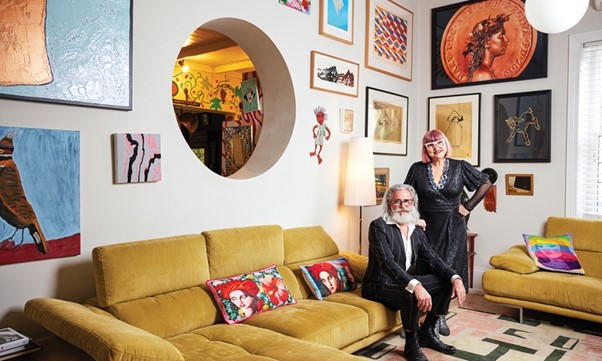
Nick Phillips and Heather Croall have transformed Heather’s parents’ Torrensville home into a gallery with all the pieces they love, predominately by South Australian artists.
Put some big personalities of the Adelaide Fringe together in the one room and you’re guaranteed a good time.
There are no wallflowers at Heather Croall’s Torrensville home for her pre-Fringe get-together.
It’s a scene that wouldn’t be out of place during February and March on any Adelaide street.
There’s glitz and glamour, sparkle and shine, and more than anything, unabashed excitement about festival season.
Heather, the Fringe’s long-standing artistic director, has been in her kitchen preparing a seemingly simple but sentimental dish for her table, around which seasoned Fringe performers and personalities will gather.
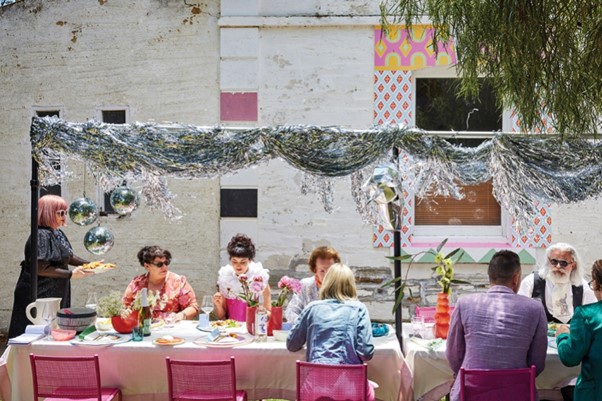
Styling for Heather Croall’s Fringe lunch was unsurprisingly quirky and glitzy, with pieces from Dinosaur Designs and In the Roundhouse.
The food she’s preparing speaks to her heritage – all sides of it. Her parents are Glaswegian, and Heather tells us in Glasgow, people fry everything. Outside, there are a couple of deep fryers warming up, ready to start sizzling.
On the menu today is fish and chips – the garfish is a nod to Whyalla, where she moved with her family when she was four years of age.
“The fishery there was just a little tin shed on the beach,” Heather says.
“The fishermen would come out of the water and take it in, that’s how fresh it was.”
Soon enough for Heather, a life in the arts came knocking and she spent 10 years in England working for the renowned documentary film festival in Sheffield, called DocFest.
That’s where she met partner, Nick Phillips, who is resplendent in his suit and trademark handlebar moustache, ready to don a dramatic faux fur coat, which he also wears in his own show, Werewolves.
It was late 2011 when Heather and Nick met, Nick then a designer in the UK, having co-founded famed studio The Designers Republic.
It was at his former business partner’s exhibition that he met Heather for the first time.
“We walked around the exhibition together and then he had to run to catch the last train home,” Heather recalls.
Fast forward more than a decade and they now live in the home that once belonged to Heather’s parents – which they bought in 1984 – but Heather and Nick have since made it very much their own.
The walls in their living space are covered with the spoils of a lifetime of art collecting and South Australians artists feature prominently.
There’s work from photographer Alex Frayne and DJ and artist Driller Jet Armstrong. There are pieces even closer to home, created by Heather’s son Lucas.
Outside, the front of the home also features Lucas’s work, with the artist creating a colourful pastel mural on the exterior wall which serves as a playful backdrop to the day’s table setting.
The fish and chips hit the table, readily accepted by Heather’s guests, who are perched on a long table beneath a canopy of glittering tinsel.
Heather says when she started as director and CEO of the Fringe in 2015, one of the first things that happened was being approached by a group of Adelaide magicians who demanded their own performance category, no longer wanting to be lumped in with cabaret artists.
One of the driving forces behind the magicians’ revolution – Matt Tarrant – sits across from Heather at the table. Matt, who was gearing up for his show, FATE, recalls his first time performing at Fringe in 2012 didn’t quite go to plan.
“I got escorted out of the Garden of Unearthly Delights by the police,” he says with a laugh.
“I was working with this guy – he’d called himself a ‘producer’ – and he arranged to have a close-up magic show in the middle of the Garden, almost like a street show.”
Matt carried out his 30-minute show, taking donations for charity and at the end, the Garden’s managers came up and asked who he was, why he was performing, and informed him that police were on their way.
“We had to carry this giant bed of nails through the Garden. I did ask (the ‘producer’) why I wasn’t in the program, and he said we’d missed the printing deadline.”
Live and learn. And don’t worry, it’s all official now: “Gluttony knows I’m coming,” Matt says.
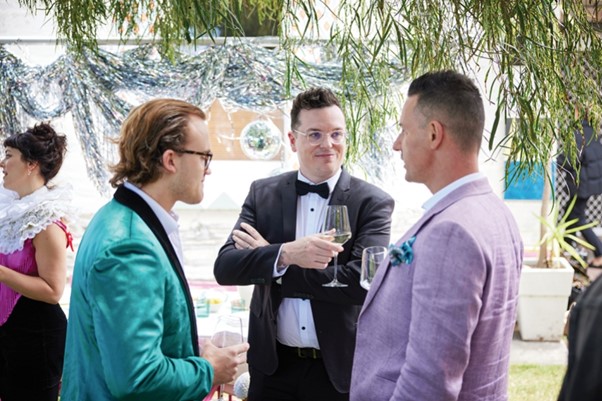
Ben Francis of tribute band The 60 Four, Matt Tarrant and Michael Griffiths chat all things Fringe.
Stories of memorable artistic debuts swirl across Heather’s table all day. Renowned cabaret artist Michael Griffiths recounts his first Adelaide Fringe back in 2014. Having lived in Sydney for 15 years working in musical theatre, Michael decided to make the move to Adelaide, lured by the Fringe and Cabaret festivals.
He was performing two shows – the songs of Madonna and Annie Lennox – and he was noticed by a talent scout, who promptly invited him to the Seychelles to perform.
“In my mind, Seychelles was kind of off the coast of Queensland,” Michael says. “They said I couldn’t ask any questions and I wasn’t allowed to know who I was performing for, but I could name my fee”.
“I spoke to some other artists who had done the same show to make sure it was legit.
“Sure enough, I go to the Seychelles and there’s a Saudi prince who likes to be entertained. He has a full proscenium arch theatre and 300 of his closest friends visit.
“He has his own box, and I was told you’re not allowed to look at it. I got paid promptly, but in hindsight, my fee was a bit too friendly. But then again, I did think I was going to Noosa.”
The guests are a perfect snapshot of everything that makes the Fringe special, from one of its creators, to the talent taking hold of audiences today.
Cabaret performer Amelia Ryan had two Fringe shows, Simply Brill with Michael Griffiths and Geriatric Womb (the 39-year-old performer started the Fringe season approaching her due date with her second child).
Ben Francis of classics tribute act The 60 Four performed his first show at Fringe when he was in Year Nine at Scotch College in 2015 and has since embarked on regional tours with the four-piece group.
Britt Plummer, meanwhile, used an Arts SA springboard to launch her performing career – she studied the art of clowning in France with a grant made available through Arts SA and this year, she brought Fool’s Paradise to The Yurt at the Migration Museum, which she programmed with Nick.
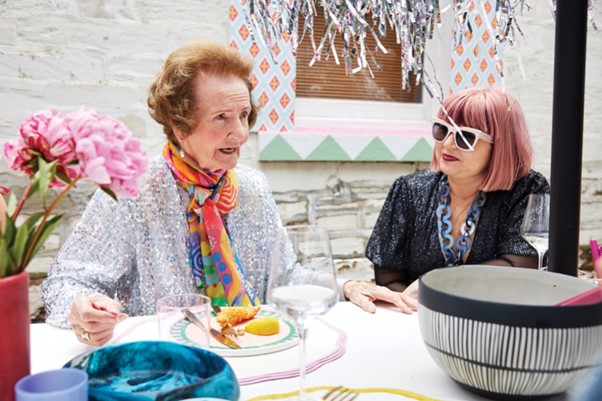
Mother of the Fringe, Marjorie Fitz-Gerald speaks about the state of the arts in South Australia while Heather listens intently.
On this table, 90-year-old Marjorie Fitz-Gerald is royalty. She, along with the Fringe’s founding father, Frank Ford, brought the festival to life back in 1960. Her importance in the development of the careers of those sitting around the table is not lost on anyone.
Heather knew of Marjorie from a distance during her early days working with the Fringe, but it wasn’t until she became artistic director in 2015 that the two met properly.
“From the very beginning, Marjorie gave me a lot of encouragement and confidence to always keep the Fringe fresh and innovative,” Heather says.
“She helped us grow the philanthropic side of Fringe. She’s the founding mother of Fringe from all those years ago, but she hasn’t stopped supporting us.”
Heather recalls a function in 2017 to raise funds for Fringe, which Marjorie hosted at her house. “She was probably 85 years old, and she’d already hosted six other functions for other arts organisations that year.
“Marjorie is one of a kind – the arts in South Australia wouldn’t look the same without her.”
One lesson Heather has taken from Marjorie is that Fringe must be about the artists above all else.
That focus is something that each artist here today recognises and relishes.
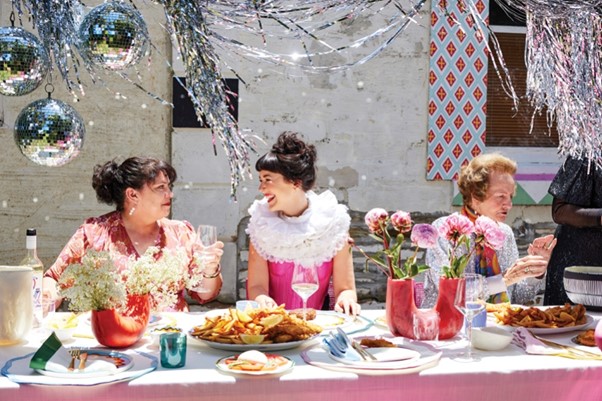
Singer/songwriter Nancy Bates and Britt Plummer discuss the launch of their careers.
Singer, songwriter and composer Nancy Bates was an Artist Fund recipient, and she couldn’t be more grateful for the support.
Nancy, who toured with Archie Roach for three years from 2014 is about to embark on a regional tour with her show, Still Talking ’Bout a Revolution.
“Knowing I had that financial security enabled me to get the show going without that compounded stress and anxiety around selling tickets or getting sick or being able to pay the band,” she says.
“No other festival even comes close to the one-on-one support that Fringe provides.”
This year, Nancy performed her show on the Fringe’s opening night on February 17, at the Space Theatre. The show uses the songs of American singer/songwriter Tracy Chapman to reflect on First Nations narratives in Australia.
“I wanted to do the show because I love Tracy’s songs and sadly, the content of the songs she released 30 years ago is still so relevant to so many social issues, especially the issues we find in the community here with First Nations people surrounding domestic violence, the environment and the racial divide.
“I wanted to say something to this country and working with somebody else’s songs and attaching them to my own narrative, I was able to externalise more and be a bit bolder.”
Nancy, a Barkindji woman on her dad’s side, is from far western New South Wales and escaped domestic violence when her then-toddler’s father was imprisoned.
She and her three-year-old daughter moved to Adelaide and couch-surfed until she found a job in child protection with an Aboriginal family support service.
Nancy’s daughter, now 24, will soon graduate with a degree in archaeology and the past two decades have inspired Nancy’s own songs.
It’s this healing journey that exemplifies something Heather is looking to do with the future of Fringe, with the help of board member and SAHMRI senior research fellow, Odette Pearson.
“There’s a lot of work we can do to demonstrate how engaging in the Fringe as an artist or audience member can have a really positive impact on your health and wellbeing,” Heather says.
“It’s something I’m keen to get some work done on and measure because I think the arts can save the health budget.
“There have been a lot of reports about the subject in Europe, with doctors actually prescribing the theatre and the arts instead of drugs.”
Nancy is a firm believer in the healing power of the arts – she’s felt it in her own life.
“There’s a song of Uncle Archie’s about getting to the top of the hill and looking back on how far you’ve come,” she muses. “I look back and see who I am now compared to who I was and how I’ve grown and healed through the arts.
“That’s the role of the arts – whatever we’ve been through, whether it’s as a child or struggles we’re up against now, the arts have the capacity to heal and externalise painful stories and create something beautiful from pain.”
Words: Zoe Rice
Images: Andre Castellucci


